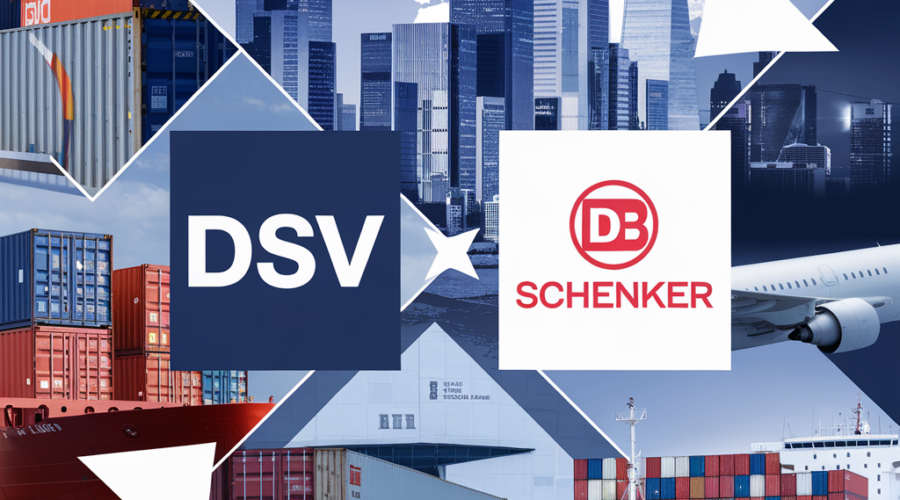The European Commission’s unconditional approval of DSV’s €14.3 billion acquisition of DB Schenker marks a pivotal moment in global logistics consolidation[1][4][9]. This transaction creates the world’s largest freight forwarder with combined revenues of €39.3 billion and 147,000 employees across 90 countries[3][5][10]. While the deal faced scrutiny from 35 regulatory bodies, its clearance underscores the fragmented nature of logistics markets where the combined entity will control just 6-7% of global operations[9][11][13]. The strategic move enables Deutsche Bahn to reduce €30 billion debt while positioning DSV to challenge market leaders DHL and Kuehne+Nagel through enhanced airfreight capabilities and transcontinental reach[6][10][13].
Regulatory Landscape and Competitive Analysis
EU Competition Assessment
The European Commission’s Phase I clearance concluded the merger wouldn’t distort competition due to three key factors: market fragmentation across 27 EEA countries, presence of alternative providers like GEODIS and CEVA Logistics, and low combined market shares in specialized logistics segments[4][7][12]. Detailed analysis of 14 national markets revealed overlapping operations only in Nordic countries’ road freight sectors, where DSV agreed to divest certain terminal assets[12][13]. This contrasts with previous logistics mergers requiring remedies, indicating regulators’ comfort with current market dynamics[9][11].
Global Regulatory Hurdles
With US Department of Justice approval pending, DSV faces its final regulatory test in a market where combined airfreight volumes would reach 2.5 million tons annually[13]. Bernstein analysts note the parties’ lower US market shares compared to EU levels reduces antitrust risks, though potential scrutiny remains over automotive logistics where DB Schenker holds 18% of transatlantic vehicle shipments[6][10]. Chinese regulators imposed minor conditions on port operations but allowed the deal’s structural integrity, avoiding the protracted reviews seen in tech sector mergers[13].
Financial Engineering and Deal Structure
Capital Allocation Strategy
DSV’s financing mix of €4-5 billion equity and €9.3 billion debt represents a 2.5x leverage ratio against pro forma EBITDA[5][8]. The equity portion includes a €3.2 billion rights issue priced at 5% discount to 30-day VWAP, with AP Moller-Maersk participating to maintain its 8% stake[10][11]. Debt financing combines €6 billion in senior secured notes (BBB+/Baa1) and a €3.3 billion syndicated loan from Nordic banks[5][8]. This structure preserves DSV’s investment grade rating while funding the largest logistics acquisition since XPO Logistics’ 2015 spree[6][10].
Synergy Realization Targets
Management projects €980 million annual cost synergies by 2027 through four primary levers: 23% reduction in overlapping air/ocean freight routes, consolidation of 58 European warehouses, IT platform integration using DSV’s CargoWise system, and workforce optimization[3][10][13]. Revenue synergies of €420 million are anticipated from cross-selling contract logistics capabilities to DB Schenker’s automotive clients and leveraging combined purchasing power with airlines[6][13]. These estimates appear conservative compared to DSV’s historical 112% synergy achievement rate in previous acquisitions[10].
Strategic Implications for Key Markets
Automotive Logistics Dominance
The merger creates Europe’s largest finished vehicle logistics operator with 12.8 million annual vehicle movements[6][8]. Combined capabilities in roll-on/roll-off shipping (DSV’s 15% market share) and inland distribution (DB Schenker’s 22% EU rail freight) position the entity to challenge Gefco and BLG Logistics[6][13]. Immediate opportunities exist in electric vehicle battery logistics where DB Schenker’s temperature-controlled solutions complement DSV’s Asian manufacturing hubs[3][6].
Airfreight Capacity Leverage
Post-merger air cargo volumes of 2.5 million tons annually give DSV-Schenker 9.2% global market share, surpassing Kuehne+Nagel’s 8.7%[13]. The combined charter network will operate 47 dedicated freighters, including 12 new Boeing 777 conversions planned for 2026[13]. This scale enables renegotiation of bellyhold contracts with major airlines, particularly on Asia-Europe routes where the entity controls 14% of capacity[10][13].
Workforce Integration Challenges
Labor Redundancies and Union Negotiations
DSV’s integration plan identifies 1,600-1,900 German job cuts primarily in overlapping back-office functions, representing 7% of the combined domestic workforce[10][13]. The Verdi union secured a three-year job protection agreement for remaining staff, coupled with €1 billion investment in automation systems to offset labor reductions[8][13]. Cultural integration poses risks given DSV’s decentralized model versus DB Schenker’s hierarchical structure – a challenge mirrored in the 18-month leadership alignment program for 2,300 managers[3][10].
Technology Platform Consolidation
The migration of DB Schenker’s 62 legacy IT systems to DSV’s cloud-based infrastructure represents a €230 million project over 30 months[5][13]. Key challenges include reconciling customs clearance platforms (ATLAS vs. NCTS) and integrating real-time tracking systems without disrupting 18,000 daily cross-border shipments[12][13]. The combined entity will adopt DSV’s AI-powered predictive logistics engine, enhancing route optimization for 85,000 daily truck movements[6][13].
Future Market Dynamics and Competitive Response
Competitor Strategic Moves
DHL Global Forwarding responded by accelerating its €500 million digital transformation program, while Kuehne+Nagel announced a share buyback to counter potential investor defections[9][10]. Maersk’s withdrawal from bidding reflects strategic focus on end-to-end container logistics, though analysts suggest it may acquire regional players like Hellmann to maintain market position[3][10]. The deal could spark consolidation among mid-sized firms like Agility Logistics and Bolloré Logistics seeking scale[11][13].
Sustainability Initiatives
The merged entity committed to 50% emission reductions by 2030 through three primary initiatives: deployment of 3,200 electric trucks in Europe, sustainable aviation fuel (SAF) partnerships covering 30% of airfreight, and solar-powered warehouses generating 740 GWh annually[3][8][13]. These targets exceed industry averages but face scrutiny over DB Schenker’s existing coal-powered facilities in Eastern Europe[8][13].
Conclusion: Redefining Global Supply Chain Economics
This acquisition reshapes competitive dynamics in three fundamental ways. First, it creates unprecedented scale in high-margin contract logistics (combined €8.9 billion revenue)[5][10]. Second, it positions DSV-Schenker as the primary challenger to integrated players like FedEx in time-sensitive healthcare logistics[6][13]. Finally, the deal’s success hinges on executing complex integration during global trade uncertainty, with 2025 guidance projecting 4-6% organic growth despite macroeconomic headwinds[10][11]. As regulatory scrutiny intensifies in logistics, this merger may represent the last mega-deal of its kind, pushing competitors toward niche specialization or partnership models.
Sources
https://cargofacts.com/allposts/eu-approves-dsv-acquisition-of-db-schenker/, https://shippingwatch.com/logistics/article18078656.ece, https://www.sustainabletruckvan.com/dsv-db-schenker-acquisition-official/, https://indiaseatradenews.com/ec-approves-dsv-takeover-of-db-schenker/, https://www.dsv.com/en/about-dsv/press/news/com/2024/09/dsv-signs-agreement-to-acquire-schenker, https://www.automotivelogistics.media/news-and-features/dsv-acquires-db-schenker-in-143-billion-deal/46080.article, https://motortransport.co.uk/ec-gives-dsv-green-light-to-db-schenker-acquisition/25959.article, https://www.deutschebahn.com/en/presse/press_releases/Supervisory-Board-of-Deutsche-Bahn-AG-approves-sale-of-logistics-subsidiary-DB-Schenker-to-DSV-13092854, https://www.marketscreener.com/quote/stock/DSV-A-S-65289675/news/DSV-gains-EU-green-light-for-15-8-billion-Schenker-deal-49573173/, https://www.morningstar.com/news/dow-jones/202504096424/deutsche-bahns-12-billion-schenker-sale-approved-by-eu, https://www.marketscreener.com/quote/stock/DSV-A-S-65289675/news/EU-gives-go-ahead-for-DSV-s-acquisition-of-Schenker-49573704/, https://eur-lex.europa.eu/legal-content/EN/TXT/PDF/?uri=OJ%3AC_202501615, https://www.aircargonews.net/acquisitions/eu-approves-dsvs-acquisition-of-db-schenker/1079935.article





